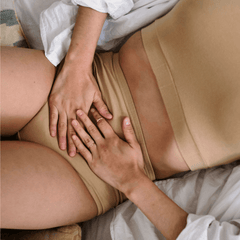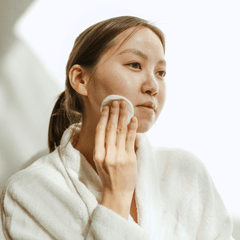Estrogen Dominance in Women: Symptoms, Causes, Treatment

What if your acne, mood swings, or painful periods aren’t just “normal” female issues, but signs of estrogen dominance? While precise statistics are lacking due to limited research, experts estimate that around 72% of women experience estrogen dominance—yet it often goes undiagnosed. In this guide, we’ll explore the symptoms and show you how to naturally lower estrogen levels to restore balance and feel like yourself again.
What is Estrogen Dominance?
Estrogen and progesterone are sister hormones that regulate one another. Together, they help regulate the menstrual cycle, skin health, bone health, and other important bodily functions. Estrogen dominance is a hormone imbalance that occurs when there’s too much estrogen in the body relative to progesterone. Excess estrogen occurs because the body is making too much, it’s coming from an external source, or it’s recirculating because the body isn’t sufficiently detoxifying estrogen. This imbalance can lead to a variety of symptoms that range from mild to severe and can affect your physical and emotional health.
Estrogen dominance is about the ratio between estrogen and progesterone. In other words, it isn’t always caused by high estrogen—though that’s the most common reason. Some women have normal estrogen levels but low progesterone, which can still lead to estrogen dominance and its effects.
Estrogens can generally be classified as “good” or “bad.” The good estrogens are naturally produced by the body and are easily eliminated. The bad estrogens often come from synthetic sources like pesticides, plastics, and other chemicals. These bad estrogens linger in the body, sticking to hormone receptors and causing damage. Because they persist in the system, they are often responsible for the harmful effects of elevated estrogen levels.
How Does Estrogen Dominance Cause Hormonal Acne?
Testosterone is the focus of most hormonal acne conversations since it converts into an active form, called DHT, which directly impacts the amount of oil your pores produce. High levels of DHT trigger an increase in oil production. Eventually, the oil builds up, clogs pores, and causes hormonal acne.
One of progesterone’s key roles is to keep DHT balanced. Since estrogen and progesterone work together, too much estrogen means your body has too little progesterone in comparison. When relatively low, progesterone can no longer keep DHT in check, resulting in the hormonal chaos that leads to acne.
Ultimately, hormonal acne is a key symptom of estrogen dominance, particularly when breakouts occur along the mouth, chin, or jawline. While the reason behind this placement is debated, some believe it’s related to the skin in this area having a higher density of sebaceous glands and/or being more sensitive to androgens.
Learn more about the connection between hormonal acne and estrogen dominance.
Other Estrogen Dominance Symptoms in Women
Understanding the symptoms of estrogen dominance is the first step in determining if you’re dealing with this hormone imbalance. Here are some common signs:
Premenstrual Syndrome (PMS)
Premenstrual syndrome (PMS) refers to a range of physical and emotional symptoms that occur specifically during the luteal phase of the menstrual cycle—after ovulation and leading up to the start of your period. PMS is typically connected to estrogen dominance. This is likely because in a "normal," balanced cycle, progesterone exceeds estrogen in the luteal phase, but with estrogen dominance, the reverse may occur—estrogen may exceed progesterone, intensifying the symptoms associated with this hormone imbalance.
PMS symptoms can include hormonal acne, mood symptoms (irritability, anxiety, depression), bloating, swelling, fluid retention, breast tenderness, and headaches or migraines. It’s important to note that while these symptoms appearing or worsening during the luteal phase is a key identifier of estrogen dominance, they can also show up during other phases of the cycle.
Mood Symptoms
Estrogen influences the brain's neurotransmitters, including serotonin and dopamine. Too much can overstimulate these systems, causing anxiety, irritability, and, as hormones fluctuate throughout the cycle, rapid changes (mood swings). In a typical cycle, progesterone works as a calming counterbalance to estrogen. When progesterone is low, as is the case with estrogen dominance, the calming effects of progesterone are reduced, leaving the overstimulating effects of estrogen more pronounced.
Bloating, Swelling, or Fluid Retention
Estrogen plays a key role in water retention, and when it is too high relative to progesterone, the body can hold onto excess fluid, leading to bloating and swelling, particularly in the abdomen, breasts, and lower extremities. Progesterone, on the other hand, has a natural diuretic effect, helping to balance fluid levels in the body. When progesterone is low, the body’s ability to eliminate excess fluid is compromised, which can worsen symptoms of bloating and swelling.
Breast Tenderness or Fibrocystic Breasts
Estrogen influences breast tissue by promoting fluid retention and stimulating changes in the ducts and glands. Too much estrogen relative to progesterone can lead to swelling, tenderness, and the formation of fluid-filled cysts—features of a condition known as fibrocystic breasts. This condition is characterized by lumpy, sometimes painful breasts that can fluctuate in size and tenderness, often worsening in the days leading up to menstruation.
Headaches or Migraines
Estrogen increases the dilation of blood vessels, and when levels are too high relative to progesterone, it can lead to excessive dilation, which may trigger headaches by increasing pressure in the brain. Progesterone, which has calming and anti-inflammatory effects, helps counterbalance estrogen’s impact, so when progesterone is low, headaches may become more frequent or severe.
Weight Gain
Estrogen promotes fat storage, particularly in areas like the hips, thighs, and abdomen, so higher levels of estrogen can lead to increased fat in these areas. At the same time, fat tissue produces estrogen, meaning higher levels of body fat can contribute to estrogen dominance. This can result in a vicious cycle: excess fat produces more estrogen, which then promotes further fat storage, leading to even higher estrogen levels and more fat accumulation.
Heavy or Painful Periods
Estrogen stimulates the growth of the uterine lining—the tissue that sheds during menstruation and causes bleeding. When estrogen levels are disproportionately high, the uterine lining can become overly thickened. This excessive buildup leads to heavier, often longer, periods and can contribute to more intense cramping and discomfort, as the body works harder to shed the thickened tissue.
While painful periods are a common symptom of estrogen dominance, severe pain can signal chronic conditions like endometriosis. For a deeper understanding of how endometriosis, period pain, and acne intersect, explore our endometriosis guide.
What Causes Estrogen Dominance?
While there are many factors that can contribute to estrogen dominance, the most common causes can be grouped into a few key categories.
Endocrine-Disrupting Chemicals
Endocrine-disrupting chemicals (EDCs) can be found in countless everyday products, including food products. Many of these EDCs are considered xenoestrogens—chemicals that mimic estrogen in the body.
The average diet includes foods that contain some form of EDCs—pesticides, hormones and antibiotics in livestock, preservatives and other additives in processed foods, etc. Food packaged in plastic or aluminum tins is also likely to contain these harmful chemicals as a result of the packaging (BPA, phthalates, etc.). As we know, a lot of these chemicals mimic estrogen in the body, binding to estrogen receptors, and building up over time.
Personal care products are another major offender (skin care, makeup, hair care, and deodorant, etc.) These products often contain parabens, phthalates, artificial fragrances, and a variety of other chemicals that can be classified as xenoestrogens. Since they are applied directly to your body, it’s easy for them to enter the bloodstream through the skin. With everyday use, their effects can accumulate, contributing to chronic imbalances like estrogen dominance.
EDCs can also be found in:
-
Plastics, like containers and water bottles
-
Certain cookware, like teflon pans
-
Certain household products, like cleaning products and candles
-
Certain medications, like birth control pills and conventional hormone replacement therapy
-
Tap water—because these EDCs are so powerful, they aren’t filtered out of our water supply, meaning every time you drink water from your tap, you are likely consuming environmental estrogens
Poor Liver and Gut Health (Poor Detoxification)
The liver and gut are essential for detoxifying harmful toxins, including excess estrogen. When these organs aren’t functioning optimally, the body has a harder time flushing out estrogen and other toxins. A lack of key nutrients, like protein and fiber, can contribute to a weak liver and gut, while excessive caffeine, alcohol, and other drugs can overwhelm these organs and further impair detoxification.
Beta-glucuronidase is an enzyme that can be found in the gut, particularly in people with estrogen dominance. Beta-glucuronidase can interfere with the process of estrogen detoxification by breaking the conjugated forms of estrogen (which were supposed to be excreted) back into their active, reabsorbable forms. This process allows estrogen to be reabsorbed into the bloodstream, preventing healthy estrogen balance. Constipation can also play a role in gut health, as it slows down the elimination of estrogen through stool, allowing it to recirculate in the bloodstream and contribute to estrogen dominance.
Excess Body Fat
Overconsumption of fat, particularly unhealthy fats like those found in fried foods, contributes to the development of fat cells. These fat cells store and increase the production of estrogen, which can lead to an imbalance in the body's hormone levels. This increased estrogen storage can be particularly problematic in individuals who are obese, as fat cells become more active in hormone production. Lack of exercise further exacerbates this issue by hindering the body's ability to metabolize estrogen and regulate hormone levels.
Chronic Stress
Chronic stress can elevate cortisol levels, which in turn can lower progesterone production. As progesterone drops, estrogen dominance becomes more likely, as the balance between estrogen and progesterone is disrupted. Chronic stress can also impact the liver and gut’s ability to efficiently process and eliminate excess estrogen. This results in estrogen staying in the body longer than necessary, contributing to its accumulation and exacerbating symptoms like hormonal acne.
How to Treat Estrogen Dominance Naturally
What you eat and how you live can significantly influence estrogen levels. A diet that supports proper estrogen detoxification, along with a healthy lifestyle, are essential in managing estrogen dominance. Here are some practical steps you can take to support your health and alleviate estrogen dominance symptoms.
Reduce Exposure to EDCs
-
Consume a nutrient-rich diet focused on organic, whole foods.
-
Read ingredient labels. This applies to food, beauty and personal care products, cleaning products, etc. Avoid items that contain chemicals like parabens, phthalates, BPA, and artificial fragrances.
-
Use glass or stainless steel containers for food and beverages instead of plastic.
-
Avoid cooking with non-stick pans.
-
Filter drinking water to remove contaminants that may be present in tap water.
Enhance Detoxification
-
Limit caffeine and alcohol to support the liver’s ability to detoxify excess estrogens.
-
Incorporate cruciferous vegetables (broccoli, cauliflower, kale) into your diet. These veggies contain a compound called DIM (diindolylmethane) that supports the first phase of estrogen detox, which focuses on metabolism—breaking down estrogen into metabolites.
-
Consider supplements that help lower estrogen levels. DIM can be consumed in supplement form, but it’s critical to simultaneously support the second and third phase of estrogen detox (conjugation and elimination). This prevents metabolized estrogens from re-entering the bloodstream and perpetuating estrogen dominance. Balance is the first hormonal acne supplement that supports all phases of estrogen detox. Along with 150mg of DIM, it contains 200mg of glutathione, which supports the second phase, and 150mg of calcium-d-glucarate, which supports the final phase.
-
Consume a fibre-rich diet (e.g., fruits, vegetables, legumes, whole grains) to encourage healthy digestion and regular elimination of excess estrogens.
-
Stay hydrated by drinking plenty of water throughout the day to support kidney function and facilitate the elimination of toxins through urine.
-
Avoid overusing antibiotics, which can disrupt the balance of gut bacteria and worsen estrogen dominance.
Manage Stress
-
Sleep 7-9 hours each night. Lack of sleep causes your body to react as if it’s in distress, releasing more cortisol. Sleep helps calm and restore the body so that you’re better able to cope with stressful situations. Quality sleep also gives your body and skin the chance to heal and repair itself.
-
Exercise a few hours each week. Physical activity produces endorphins and serotonin which elevate and stabilize your mood in a way that helps reduce stress. Physical activity can also help relieve physical stress caused by muscle tension, and help maintain healthy body fat levels.
-
Incorporate relaxation techniques, like yoga, meditation or deep breathing. Taking time for self-care and engaging in activities you enjoy—whether spending time in nature or journaling—can help you maintain a balanced, healthy hormonal profile.
Achieving Estrogen Balance
Estrogen dominance can be a frustrating and overwhelming condition, but with the right knowledge and approach, it’s absolutely manageable. By understanding the symptoms, causes, and potential impacts of estrogen dominance on your health, you can take steps toward restoring balance and feeling better in your body.
If you think your hormonal acne or other symptoms might be caused by estrogen dominance, our hormone imbalance quiz is a great first step to find answers and determine next steps.
If you’re confident estrogen dominance is at the root of your issues and ready to tackle this hormone imbalance head-on, try Balance risk-free. If you're not satisfied, just reach out within 30 days for a refund.
Don’t let perpetual breakouts, frustrating mood swings, and painful periods control your life. With the right approach, you can achieve estrogen balance and feel at home in your skin, every single day.





